




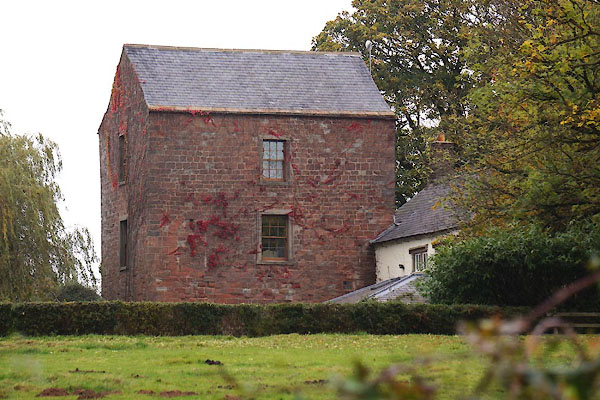
CEC96.jpg (taken 23.10.2015)
placename:- Linstock Castle
"Linstock Castle"
"Castle (Remains of)"
placename:- Lynstok Castle
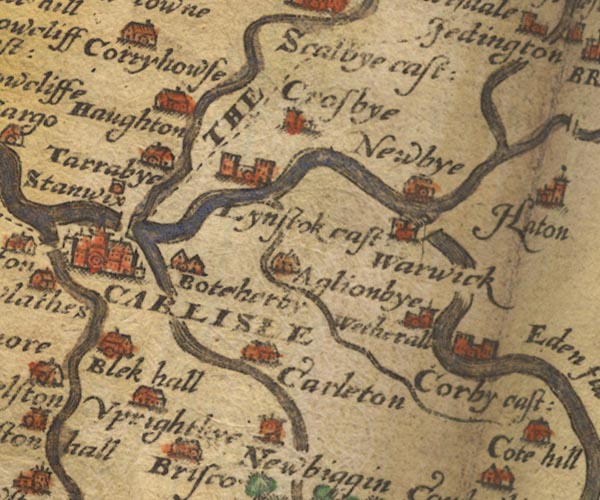
Sax9NY45.jpg
Building with two towers, symbol for a castle. "Lynstok cast"
item:- private collection : 2
Image © see bottom of page
placename:- Lynstoke Castle
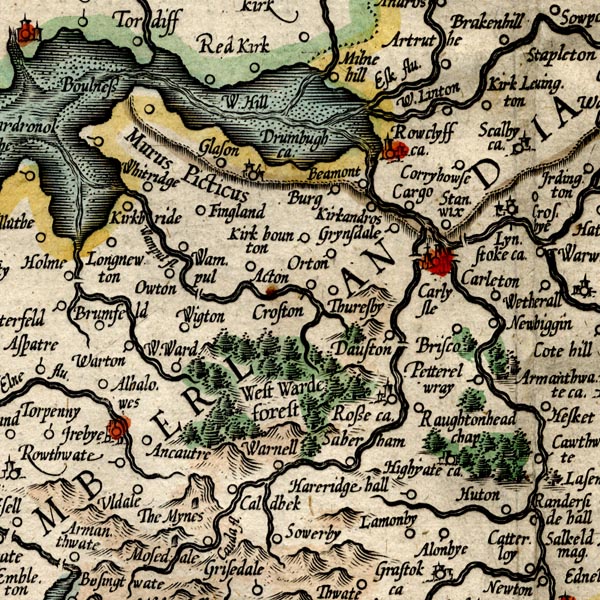
MER8CumC.jpg
"Lynstoke ca."
circle, building and tower
item:- JandMN : 169
Image © see bottom of page
placename:- Lynstik Castle
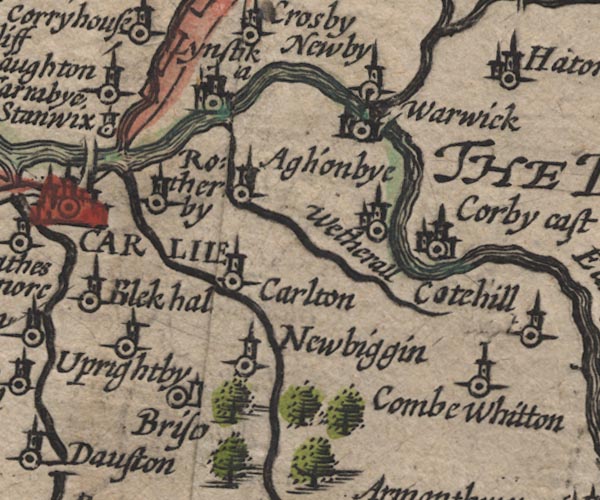
SP11NY45.jpg
"Lynstik [c]a"
circle, buildings, tower
item:- private collection : 16
Image © see bottom of page
placename:- Lynstok Castle
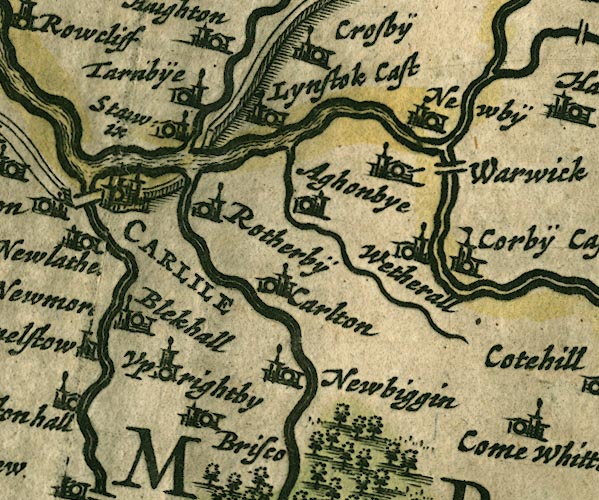
JAN3NY45.jpg
"Lynstok Cast"
Buildings and tower with flag.
item:- JandMN : 88
Image © see bottom of page
placename:- Lynstok Castle
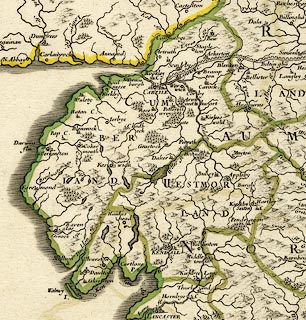 click to enlarge
click to enlargeSAN2Cm.jpg
"Lynstok C."
circle, two towers, flag; castle
item:- Dove Cottage : 2007.38.15
Image © see bottom of page
placename:- Lynstock Castle
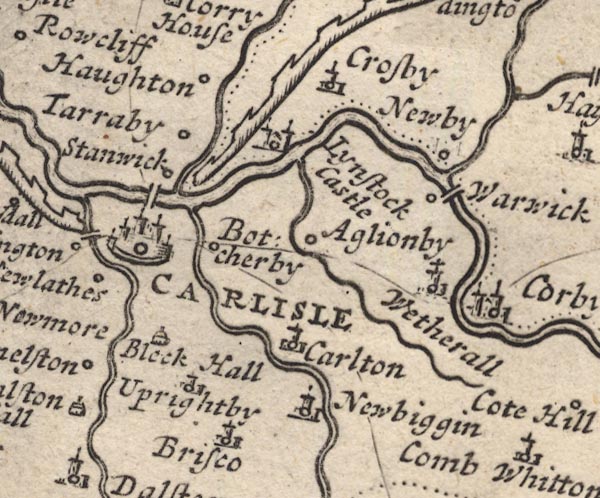
MD12NY45.jpg
"Lynstock Castle"
Circle, building with two towers.
item:- JandMN : 90
Image © see bottom of page
placename:- Linstock Castle
 goto source
goto source"..."
"Linstock, a Castle of the Bishop of Carlisle. The Barony was first given by King Henry I. to one Walter, his Chaplain, to hold of him and his Successors, the Kings of England; but Walter voluntarily taking upon him a religious Life, with the King's Licence in the Priory of St. Mary's at Carlisle, the King gave Linstock to the Canons in pure Alms. The Bishop's See was after erected at Carlisle by the same King in 1133; but the Lands were enjoy'd by the Bishop and Convents, who had the Power of Election in common, 'till Pandolf, the Pope's Legate, made a Division, and so the Barony of Linstock became the Possessions of the See of Carlisle, as it continues to this Day."
placename:- Linstock Castle
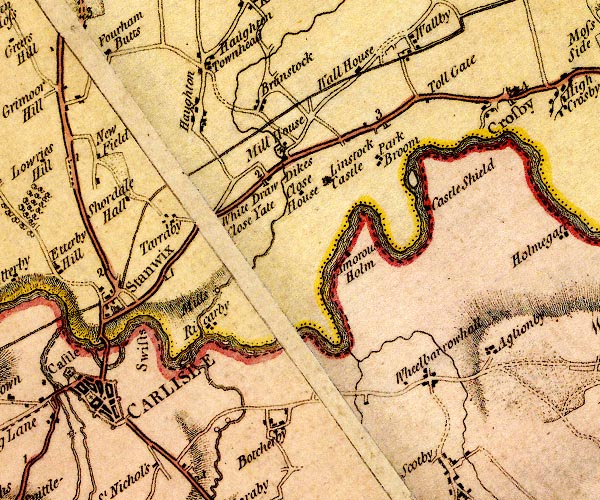
D4NY45NW.jpg
"Linstock Castle"
large building; a castle
item:- Carlisle Library : Map 2
Image © Carlisle Library
placename:- Lynstock Castle
 goto source
goto sourcePage 105:- "..."
"I do not find any ancient authors mention a castle here [Castlerigg], Speed, who speaks of twenty-five in Cumberland, hath found out every one I ever heard or knew of, except Kirkoswald; how that has escaped him I cannot tell. I shall here put down their names, and, as well as I can, their most ancient owners, and supposed founders."
"..."
 goto source
goto sourcePage 106:- "..."
"8. LYNSTOCK. Waldeof son of Gospatrick."
"..."
placename:- Linstock Castle
placename:- Olenacum
item:- placename, Linstock; Olenacum
 goto source
goto sourcePage 174:- "..."
"... Linstock, a castle of the bishops of Carlisle, in the barony of Crosby, which barony Waltheof, son of earl Gospatric and lord of Allerdale, gave to the church of Carlisle, and which I take to be called by contraction from OLENACUM. For that place seems to have been on the wall where the first Ala Herculea served against the barbarians. ..."
 goto source
goto sourcePage 191:- "..."
"Linstock was granted with Carleton by Henry I. to Walter his chaplain, who took upon him a religious habit in St. Mary's priory, Carlisle, and with the king's consent gave both manors to that in frank almoyne for ever, and became prior there. For some time the bishop and convent held all their lands in common: but when the first partition was made by Gualo the pope's legate this barony fell to the bishop, and this castle was his seat so late as 1293."
 goto source
goto sourceGentleman's Magazine 1819 part 1 p.405
From the Compendium of County History:- "1307. From Lanercost priory, March 1, Edward I. and his Queen Margaret removed to Kirk Cambock; thence on the 4th to Linstock castle, where they were entertained for six days by John Halton Bp. of Carlisle; ..."
placename:- Linstock Castle
courtesy of English Heritage
"LINSTOCK CASTLE / / / STANWIX RURAL / CARLISLE / CUMBRIA / II[star] / 77660 / NY4289758484"
courtesy of English Heritage
"Farmhouse, formerly tower house. C12 or early C13 as palace for the Bishops of Carlisle, with C17-C20 additions and alterations. Tower has large blocks of red sandstone, mostly from Roman Wall nearby, for walls 2 metres thick; slate gabled roof. 3 storeys, one bay, tower. entrance to ground floor, has chamfered rounded arch with continuous hood-mould hidden by ivy: above left is original first-floor entrance with rounded arch, now filled. Windows inserted 1768 with plain freestone surrounds, sashes with glazing bars, C19 plank door. East face has 2 round-headed lancets and one flat-headed chamfered lancet, now all filled. Ground floor chamfered lancet to west face. C20 steel casement in north face. Interior has pointed arch vaulting to ground floor without stairs: first-floor room connected to 2 second-floor rooms by stair in thickness of the wall. Walls originally higher and flat roof, reduced and gabled 1768. Extension at right angles of 2 storeys, 2 bays has sandstone rubble walls partly covered by render, is probably early C17 incorporating parts of an earlier out building. Two C17 chamfered mullion windows with mixed C19 and C20 sashes, with with single glazing bars and steel casements. Further one bay early C19 extension of brick under same roof with C20 kitchen extension of single storey, 2 bays to side. Close to the castle are the remains of the encircling moat. Used as Bishops Palace c1219-early C14, then as prison and refuge for villagers in border raids. For 6 days in March 1307, Edward I, his Queen and Court were entertained here, whilst Parliament was held in Carlisle. See, Curwen, Castles & Towers of Cumberland &Westmorland, 1913, p. 298-9."
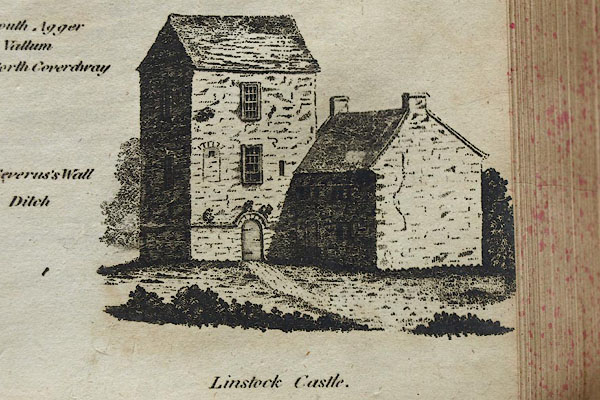
BOW98.jpg From Hutchinson 1794 map 2.
